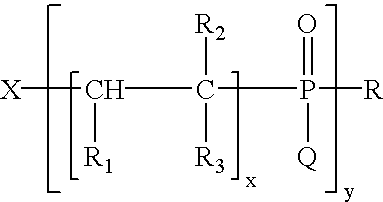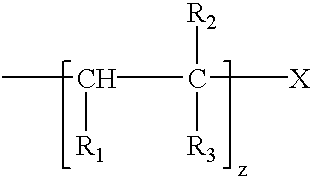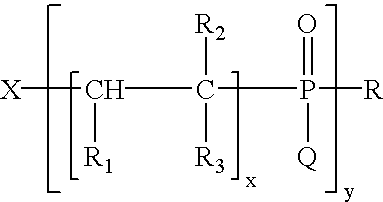Durable press treatment of fabric
a fabric and press treatment technology, applied in the field of textile finishing compositions, can solve the problems of shrinkage of textile goods, cellulose fibers, consumer dissatisfaction and complaint,
- Summary
- Abstract
- Description
- Claims
- Application Information
AI Technical Summary
Benefits of technology
Problems solved by technology
Method used
Image
Examples
example 1
Itaconic acid (65 g, 0.50 mol) is added to a 500 ml three-necked round-bottom flask fitted with a condenser, internal thermometer, magnetic stirrer, and addition funnel containing 45 ml of water. Sodium hydroxide (40 g, 0.50 mol, 50%) and sodium hypophosphite (24.6 g, 0.28 mol) are added to the reaction flask. The mixture is heated to 85° C. The reagents are treated with potassium persulfate (7.2 g, 0.27 mol) in four portions over 90 minutes. The mixture is heated for an additional 30 minutes. Hydrogen peroxide (41.4 g, 0.37 mol, 30%) is gradually added to the mixture over 3 h. Once addition is complete, the mixture is heated for 1 h at 100° C. The cooled mixture is isolated as a liquid.
example 2
Maleic acid (29.0 g, 0.25 mol) and itaconic acid (32.5 g, 0.25 mol) is added to a 500 ml three-necked round-bottom flask fitted with a condenser, internal thermometer, magnetic stirrer, and addition funnel containing 45 ml of water. Sodium hydroxide (40 g, 0.50 mol, 50%) and sodium hypophosphite (24.6 g, 0.28 mol) are added to the reaction flask. The mixture is heated to 85° C. The reagents are treated with potassium persulfate (7.2 g, 0.27 mol) in four portions over 90 minutes. The mixture is heated for an additional 30 minutes. Hydrogen peroxide (41.4 g, 0.37 mol, 30%) is gradually added to the mixture over 3 h. Once addition is complete, the mixture is heated for 1 h at 100° C. The cooled mixture is isolated as a liquid.
example 3
Maleic acid (52.2 g, 0.45 mol) and vinylphosphonic acid (5.4 g, 0.05 mol) is added to a 500 ml three-necked round-bottom flask fitted with a condenser, internal thermometer, magnetic stirrer, and addition funnel containing 45 ml of water. Sodium hydroxide (40 g, 0.50 mol, 50%) and sodium hypophosphite (24.6 g, 0.28 mol) are added to the reaction flask. The mixture is heated to 85° C. The reagents are treated with potassium persulfate (7.2 g, 0.27 mol) in four portions over 90 minutes. The mixture is heated for an additional 30 minutes. Hydrogen peroxide (41.4 g, 0.37 mol, 30%) is gradually added to the mixture over 3 h. Once addition is complete, the mixture is heated for 1 h at 100° C. The cooled mixture is isolated as a liquid.
PUM
| Property | Measurement | Unit |
|---|---|---|
| weight | aaaaa | aaaaa |
| dimensional stability | aaaaa | aaaaa |
| shrinkage | aaaaa | aaaaa |
Abstract
Description
Claims
Application Information
 Login to View More
Login to View More - R&D
- Intellectual Property
- Life Sciences
- Materials
- Tech Scout
- Unparalleled Data Quality
- Higher Quality Content
- 60% Fewer Hallucinations
Browse by: Latest US Patents, China's latest patents, Technical Efficacy Thesaurus, Application Domain, Technology Topic, Popular Technical Reports.
© 2025 PatSnap. All rights reserved.Legal|Privacy policy|Modern Slavery Act Transparency Statement|Sitemap|About US| Contact US: help@patsnap.com



